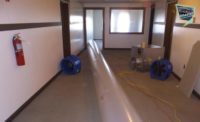Case Study
A First Time for Everything: Large Loss
A First Time for Everything: Large Loss

Photos courtesy of SunGlo Services.

Photos courtesy of SunGlo Services.

Photos courtesy of SunGlo Services.

Photos courtesy of SunGlo Services.

Photos courtesy of SunGlo Services.

Photos courtesy of SunGlo Services.

Photos courtesy of SunGlo Services.

Photos courtesy of SunGlo Services.

Photos courtesy of SunGlo Services.

Photos courtesy of SunGlo Services.

Photos courtesy of SunGlo Services.











If you had a large loss come in, when would you prefer to get the call? How about 11 o’clock on a Monday morning? That’s how this case study begins – with a broken fire suppression line at a major event center in Metro Detroit. In just 20 minutes, the broken line spewed an estimated 48,000 gallons of water through the facility. SunGlo Disaster Restoration was on site by 11:10 a.m., assessing the damage as water flowed out the front and back doors of the massive building.
In all, 150,000 square feet of space was affected.
Phase 1
With 40 full-time SunGlo employees working nearly around the clock, plus as many as 20 subcontractors, there was no time to spare to get the facility back up and operational for the Junior Olympics. The crew had 15 days.
Just hours after the initial call for help, 206 pieces of drying equipment were strategically placed for maximum drying efficiency throughout the building. Temporary power was also brought in while moisture mapping was completed, readings collected, and a full drying plan put in place abiding by the S500. Scissor lifts and some other larger equipment were rented from Sunbelt and Chet’s Rentals. Containment was set up to section off the affected portion of the building from a connected hotel, and portable restrooms were brought in until heavily-damaged restrooms could be repaired.
By day two of the project, dumpsters were on site and the entire front ceiling and a whole lot of drywall removed.
By Thursday and Friday, depending on the area, the structure was completely dry. On Thursday, crews were already putting insulation back into the walls, with drywall crews following right behind.
While SunGlo was the main company handling the loss, Jarvis Property Restoration, a fellow Metro Detroit restoration company, was called in by the public adjuster to help with this loss. Jarvis stayed on the project through phase one helping with logistics, moisture mapping, monitoring the dry-out process, and so on.
Through constant communication, the two companies were able to work together to get the facility back up and running in the narrow 15-day window before the Junior Olympics.
Phase 1 Challenges
No large loss is without its challenges! While the main goal was to have most of the work done in time for the Junior Olympics, there were still smaller events going on which meant some days, crews had to keep the noise at a minimum, or work odd hours.
Due to the large number of workers and subcontractors on site, SunGlo essentially set up an office on site to keep track of workers, time sheets, equipment, project progress, and other logistics.
Another unique challenge: due to fire ratings and building construction, there was not one … not two … but three levels of ceilings throughout the building. That meant three layers that needed attention.
Despite the challenges, through hard work, communication, and planning, phase one was completed on time.
Phase 2
With most of the public spaces in the building back up and running, phase two focused on one set of bathrooms, the facility’s server room, and a lounge area. By this point, it was mostly subcontractors handling the day-to-day work, again with some things having to be done at odd hours to avoid affecting events.
Phase 2 Challenges
This phase brought a particularly unique challenge when the design team decided to have a 15-foot-long quartz continuous trough countertop installed in the bathrooms. This required building custom steel supports to handle the weight of the nearly 1,000-pound custom counter. To make this happen, welders worked on site to get the supports into place, which also had to be bolted into concrete inside the wall. Just one week before SunGlo had to have phase two of the project complete, they had to prove to the plumbing inspector that everything had been done according to code. The day before everything was set to be installed, they got their approval.
Phase 3
As you are reading this, SunGlo is in the final phase of this project – and hopes to have it complete by next month. Many of the initial repairs were more temporary in nature to avoid forcing the facility to shut down and lose major revenue. Now, items that were initially salvaged to avoid event cancellations are being removed, other areas are being touched up, some carpet and tile that had been dried and disinfected for the time being is now being replaced, and temporary lighting switched out for permanent fixtures.
In the beginning of the project, the adjuster had been concerned about the amount of money being spent to put in temporary structures to keep the facility operational. However, that method saved the facility and insurance company millions of dollars had a loss-of-business claim been necessary.
A First Time for Everything
As for the next job, SunGlo would do a few things differently, like setting up a trailer on site to run the job from there, add time lapse cameras inside and outside the building to document the progress, and take even more photos than the hundreds already populated in DASH.
For SunGlo, this job was a big step in the right direction for their business. It was the largest commercial job ever taken on by the company that’s now been in business as a Metro Detroit staple for several decades. They’re hopeful this job will open up other large loss opportunities, especially thanks to the strong relationship now built with the owner of this massive event facility who has many connections in the community. That owner was amazed at everything the team was able to accomplish in such a short window of time.
Looking for a reprint of this article?
From high-res PDFs to custom plaques, order your copy today!

















